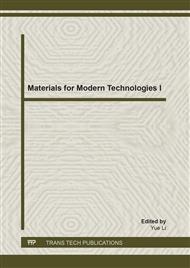[1]
Y. Abe, T. Kudo, H. Tomioka, Preparation of continuous zirconia fibres from polyzirconoxane synthesized by the facile one-pot reaction, J. Mater. Sci. 33 (1998) 1863-1870.
DOI: 10.1023/a:1004357405815
Google Scholar
[2]
Y. Abe, H. Tomioka, T. Gunji, A one-pot synthesis of polyzirconoxane as a precursor for continuous zirconia fibres, J. Mater. Sci. Lett. 13 (1994) 960-962.
DOI: 10.1007/bf00701437
Google Scholar
[3]
P. K. Chakrabarty, M. Chatterjee, M.K. Naskar, Zirconia fibre mats prepared by a sol-gel spinning technique, J. Eur. Ceram. Soc. 21 (2001) 355-361.
DOI: 10.1016/s0955-2219(00)00196-5
Google Scholar
[4]
X. Ye, J. Kuang, X. Li, G. Tang. Microstructure, properties and temperature evolution of electro-pulsing treated functionally graded Ti–6Al–4V alloy strip. J. Alloys Compd. 599 (2014) 1-9.
DOI: 10.1016/j.jallcom.2014.02.055
Google Scholar
[5]
X. Ye, G. Tang, G. Song, J. Kuang. Effect of electropulsing treatment on the microstructure, texture, and mechanical properties of cold-rolled Ti–6Al–4V alloy. J. Mater. Res. 29 (2014) 1500-12.
DOI: 10.1557/jmr.2014.171
Google Scholar
[6]
X. Ye, X. Li, G. Song, G. Tang. Effect of recovering damage and improving microstructure in the titanium alloy strip under high-energy electropulses. J. Alloys Compd. 616 (2014) 173-83.
DOI: 10.1016/j.jallcom.2014.07.143
Google Scholar
[7]
X. Ye, Y. Ye, G. Tang. Effect of electropulsing treatment and ultrasonic striking treatment on the mechanical properties and microstructure of biomedical Ti-6Al-4V alloy. J. Mech. Behav. Biomed. 40 (2014) 287-96.
DOI: 10.1016/j.jmbbm.2014.08.022
Google Scholar
[8]
H.Y. Liu, X.Q. Hou, X.Q. Wang, Fabrication of high-strength continuous zirconia fibers and their formation mechanism study, J. Am. Ceram. Soc. 87 (2004) 2237-2241.
Google Scholar
[9]
P. Niu, The Preparation and Application of Metal Oxide Fibers, Sci. Tech. Info. D&E. 19 (2009) 137-139.
Google Scholar
[10]
A. Nishimura, N. Komastu, G. Mitsui, CO2 reforming into fuel using TiO2 photocatalyst and gas separation membrance, Catal. Today. 148 (2009) 341-349.
DOI: 10.1016/j.cattod.2009.07.067
Google Scholar
[11]
G. Yu, L. Zhu, X. Wang, Fabrication of zirconia mesoporous fibers by using polyorganozirconium compound as precursor, Microporous Mesoporous Mater. 119 (2009) 230-236.
DOI: 10.1016/j.micromeso.2008.10.029
Google Scholar
[12]
A.M. Azad, Fabrication of yttria-stabilized zirconia nanofibers by electrospinning, Mater. Lett. 60 (2006) 67-72.
DOI: 10.1016/j.matlet.2005.07.085
Google Scholar
[13]
J. Li, X. Jiao, D. Chen, Preparation of zirconia fibers via a simple aqueous sol-gel method, J. Dispersion Sci. Technol. 28 (2007) 531-535.
DOI: 10.1080/01932690701277120
Google Scholar
[14]
A. Vioux, Nonhydrolytic sol−gel routes to oxides, Chem. Mater. 9 (1997) 2292-2299.
DOI: 10.1021/cm970322a
Google Scholar
[15]
J.P. Abraham, I.H. Joe, V. George, Vibrational spectroscopic studies on the natural product, columbianadin, Spectrochim. Acta. Part A. 59 (2003) 193-199.
DOI: 10.1016/s1386-1425(02)00148-8
Google Scholar
[16]
R.G. Silver, C.J. Hou, J.G. Ekerdt, The role of lattice anion vacancies in the activation of CO and as the catalytic site for methanol synthesis over zirconium dioxide and yttria-doped zirconium dioxide, J. Catal. 118 (1989) 400-416.
DOI: 10.1016/0021-9517(89)90327-8
Google Scholar
[17]
W.H. Jiang, G. Feng, J.M. Liu, Preparation of aluminum titanate film via non-hydrolytic sol-gel method and its fused salt corrosion resistance, J. Chin. Ceramic. Soc. 38 (2010) 783-787.
Google Scholar
[18]
W.H. Jiang, H.Y. Wei, G. Feng, Effect of oxygen donor alcohols on low temperature non-hydrolytic sol-gel synthesis of aluminum titanate, J. Chin. Ceram. Soc. 36 (2008) 11-16.
Google Scholar
[19]
D. W. Marshall, N. Reading, Mass, U.S. Patent 4, 323, 599. (1982).
Google Scholar


